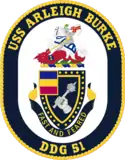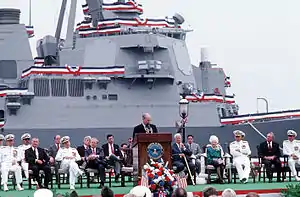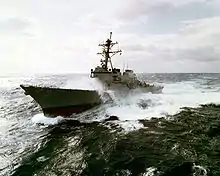USS Arleigh Burke
USS Arleigh Burke (DDG-51), named for Admiral Arleigh A. Burke, USN (1901–1996), is the lead ship of the Arleigh Burke-class guided missile destroyers. She was laid down by the Bath Iron Works company at Bath, Maine, on 6 December 1988, and launched on 16 September 1989 by Mrs. Roberta (Gorsuch) Burke. The Admiral was present in person at her commissioning ceremony on 4 July 1991, which was held on the waterfront in downtown Norfolk, Virginia.
_steams_through_the_Mediterranean_Sea.jpg.webp) USS Arleigh Burke (DDG-51) underway in the Mediterranean Sea in March 2003 | |
| History | |
|---|---|
| Name: | Arleigh Burke |
| Namesake: | Arleigh Albert Burke |
| Ordered: | 2 April 1985 |
| Builder: | Bath Iron Works |
| Laid down: | 6 December 1988 |
| Launched: | 16 September 1989 |
| Commissioned: | 4 July 1991 |
| Homeport: | NAVSTA Norfolk, Virginia, U.S. |
| Identification: | DDG-51 |
| Motto: | Fast and Feared |
| Status: | In active service |
| Badge: |
 |
| General characteristics | |
| Class and type: | Arleigh Burke-class destroyer |
| Displacement: |
|
| Length: | 505 ft (154 m) |
| Beam: | 66 ft (20 m) |
| Draft: | 31 ft (9.4 m) |
| Propulsion: | 4 General Electric LM2500-30 gas turbines, two shafts, 100,000 total shaft horsepower (75 MW) |
| Speed: | >30 knots (56 km/h; 35 mph) |
| Range: |
|
| Complement: | |
| Sensors and processing systems: |
|
| Electronic warfare & decoys: |
|
| Armament: |
|
| Aircraft carried: | 2 Sikorsky MH-60R helicopters can be embarked |
Arleigh Burke's designers incorporated many lessons learned by the Royal Navy during the Falklands campaign and from the Ticonderoga-class guided-missile cruisers. The Ticonderoga-class cruisers were becoming too expensive to continue building, and were too difficult to upgrade. Arleigh Burke's design includes what is now better known as stealth technology, which improves the ship's ability to evade anti-ship missiles. She also uses a slightly downgraded version of the Aegis combat system, which allows for launching, tracking, and evading missiles simultaneously. Her all-steel construction provides good protection for her superstructure, while her Collective Protection System allows her to operate in environments contaminated by chemical, biological, or radiological materials.
History


_prepares_to_depart_Bahrain_following_a_scheduled_port_visit_June_6%252C_2014_140606-N-WD757-013.jpg.webp)
Even before Arleigh Burke was commissioned, the Commander, Operational Test and Evaluation Force, was involved in the initial phases of testing. New systems, operated by fleet sailors ashore, were examined at land-based test facilities. The combat systems testing took place at the Combat System Engineering Development Site in Moorestown, New Jersey. The propulsion plant testing occurred at the Gas Turbine Ship Land-Based Engineering Site in Philadelphia, Pennsylvania. These test results supported the acquisition decision to begin limited production of the ship class.
After being commissioned, and throughout 1992, Arleigh Burke conducted extensive testing at sea. As is often the case with new ship classes, U.S. Navy officers and shipyard engineers encountered a number of problems with some shipboard systems that required the attention of this warship's design and production agencies. An additional phase of testing was added to verify the effectiveness of the modifications made to these systems – modifications incorporated into later destroyers of the Arleigh Burke class.
Following her initial operational testing, Arleigh Burke was deployed to the Mediterranean Sea and the Adriatic Sea in 1993, serving as the "Green Crown" during Operation Provide Promise. During her second deployment in 1995, Arleigh Burke steamed in the Mediterranean Sea as the "Red Crown" in support of the No-Fly Zone over Bosnia and Herzegovina. During her third cruise, in 1998, she steamed in the Mediterranean Sea, Adriatic Sea, Red Sea, and Black Sea, as a participant in numerous American and Allied exercises. During her fourth cruise in 2000–2001, Arleigh Burke saw service in the Mediterranean and Red Seas and in the Persian Gulf, enforcing United Nations sanctions against Iraq and conducting exercises with allied naval partners.
On her fifth deployment in 2003, Arleigh Burke and the other units of the USS Theodore Roosevelt-led carrier battle group participated in Operation Enduring Freedom and Operation Iraqi Freedom. During this wartime cruise, Arleigh Burke fired Tomahawk missile strikes against targets in Iraq, escorted merchant ships and naval auxiliaries through geographic choke-points, and carried out "leadership interdiction" operations in the northern Arabian Sea. She also undertook counter-piracy missions in the Gulf of Aden. This cruise, which lasted from January through June 2003, saw Arleigh Burke at sea over 92 percent of the time.
In March 2003 she was assigned to Destroyer Squadron 2.
Arleigh Burke has earned one Navy Unit Commendation, three Meritorious Unit Commendations, three Battle Efficiency E Awards, the National Defense Service Medal, the Armed Forces Expeditionary Medal, the Kuwait Liberation Medal, and five Sea Service Deployment Ribbons.
As a member of Destroyer Squadron 22, Arleigh Burke operated with the USS George H.W. Bush Carrier Strike Group under the direction of the Commander, Carrier Group 2.
In May 2007, Arleigh Burke ran what the Navy called a "soft aground" off Cape Henry Light at the entrance to the Chesapeake Bay.[1] Her captain, Commander Esther J. McClure, was relieved of her command shortly thereafter as a result of "loss of confidence in her ability to command".[2][3]
In October 2007, Arleigh Burke was involved in anti-pirate operations in 2007 in Somalia.
In 2009, Arleigh Burke was deployed to the eastern coast of Africa in support of AFRICOM's Africa Partnership Station. The ship represented the United States during a port visit on the island nation of Seychelles where they played a role in securing a status of forces agreement between the two countries.
In August 2010, Arleigh Burke entered the BAE Systems Ship Repair shipyard in Norfolk, Virginia for DDG Modernization, a program to upgrade the ship's systems and to extend the service life to 40 years.[4]
On 23 September 2014 Arleigh Burke took part in the 2014 military intervention against ISIS, firing Tomahawk missiles on targets in Syria while the ship was in the Red Sea.[5][6]
Ship's crest
The Shield outlined in blue and gold stands for the achievements in battle of Admiral Burke against the naval power of Japan. The fist and mace symbolize the offensive and defensive power of the new destroyer. The mace, also a symbol of authority, represents Admiral Burke's service as Chief of Naval Operations. It also refers to Admiral Marc Mitscher, an influential figure and mentor for whom Admiral Burke served as Chief of Staff. Admiral Burke's Destroyer Squadron 23, represented by the border of 23 ovals, was the only United States Destroyer Squadron awarded a Presidential Unit Citation, signified by the canton of blue, yellow, and red. The ovals also refer to the year 1923 in which Midshipman Burke graduated from the United States Naval Academy at Annapolis. Twenty-three also reflects Admiral Burke's distinguished service on the staff of the Chief of Naval Operations as (OP-23).[7]
The mounted figure of Saint George recalls Admiral Burke's celebrated victory in the Battle of Cape St. George over Japanese naval forces. His mantle bears a gold cross for the Navy Cross awarded to the Admiral. The birch branch on the helmet represents Admiral Burke himself, a reference to his name derived from his Scandinavian heritage.[7]
The red sea dragon symbolizes Japanese naval power assaulted by forces under Captain Burke's command. It is gorged with the two gold stars he was awarded for outstanding service. The lance impaling the dragon signifies ordnance on target. The capabilities of the new destroyer, the most powerful and survivable ever built, are signified by the full armor and equipment of the warrior Saint George. The Admiral's nickname "31-Knot Burke" is recalled by the number "31" on the horse.[7]
The motto of the ship is "Fast and Feared".[8] The ship's crest was designed by Mr. John Sproston of the Institute of Heraldry following a personal interview with Admiral Burke. The crest can also be found on a USPS postage stamp honoring Admiral Burke that was issued in 2010.[9]
In popular culture
- USS Arleigh Burke was featured in the opening credits in the television series JAG. It also appeared as USS Cayuga in the 1997 JAG episode "Cowboys and Cossacks".[10]
- USS Arleigh Burke was used to film the at-sea scenes in the 2003 NCIS episode "The Immortals".[11]
References
- "Inspectors check for damage to destroyer". The Virginian-Pilot. Norfolk, Virginia. 18 May 2007. p. B.5.
- Boot, Max (31 May 2007). "Fire the incompetents, find the Pattons". Los Angeles Times. Los Angeles, California. pp. A.27.
- "Ship's commanding officer relieved of duty". The Virginian-Pilot. Norfolk, Virginia. 22 May 2007. pp. B.3.
- "DDG 51 Arleigh Burke-Class Guided Missile Destroyer Modernization Program Meets Key Milestones". navyrecognition.com. 24 December 2014. Retrieved 2 October 2015.
- "US, Arab allies launch first wave of strikes in Syria". Fox News. 23 September 2014. Retrieved 23 September 2014.
- "US, Arab Partners Launch Air Attack Against ISIS Targets in Syria". cnsnews.com. Archived from the original on 23 September 2014. Retrieved 23 September 2014.
- U.S. Navy. CUSS Arleigh Burke Ship's Crest Archived 31 August 2008 at the Wayback Machine. Retrieved 18 October 2008.
- http://www.navy.mil/navydata/people/cno/burke/burkobit.txt
- "USPS Press Release" (PDF).
- "Cowboys and Cossacks". JAG. 1997.
- "The Immortals". NCIS. 2003.
Further reading
- This article includes information collected from the public domain sources Dictionary of American Naval Fighting Ships and Naval Vessel Register.
External links
| Wikimedia Commons has media related to: |